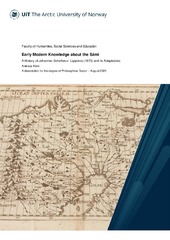| dc.contributor.advisor | Schmidt, Michael | |
| dc.contributor.author | Klein, Andreas | |
| dc.date.accessioned | 2020-12-10T12:32:47Z | |
| dc.date.available | 2020-12-10T12:32:47Z | |
| dc.date.issued | 2021-01-08 | |
| dc.description.abstract | Even though Johannes Schefferus’ Lapponia (1673) is a frequently employed source in
historical studies on the Sámi people of Fennoscandia, the book’s history and the rich reception
it aroused early on has never been studied in detail. Written in Uppsala, it was published in
Latin for an international learned readership.
One of the main intentions behind the work was to counter rumours about the presence of
Sámi sorcerers in the Swedish military. In spite of this aspect of the commission, the result was
a surprisingly factual account. Schefferus’ realistic description of the lappmarks, the regions
where the Sámi lived, featured sections on topography, natural resources, plants, and animals.
The book described the characteristics, customs, objects and commerce of the Sámi people in
detail. This way, it should restore Sweden’s reputation and demonstrate that the lappmarks were
subject to the Kingdom. Schefferus had never been to the lappmarks. Yet this did not hinder
the book’s success; already during his works on Lapponia, news about the project spread.
Adaptations in English, German, French and Dutch followed quickly.
This thesis centres on the coming into existence and development of Lapponia as a book and
a piece of literature of knowledge. Based on the original Latin version, I analyse the structures
of knowledge and the communicative network surrounding this early modern description of the
Sámi people. With the help of archival sources and mainly unpublished letters, I reconstruct the
history of Lapponia and its various adaptations.
My comparative analysis shows that the versions originating from Lapponia are widely
different when it comes to content, structure, layout and literary traditions. Furthermore, I
highlight the importance of several spheres of knowledge for the development of Schefferus’
monograph and its adaptations. Since he had not visited the area himself, Schefferus had to rely
on eyewitness accounts from the northern parts of the Kingdom. Among the authors of these
accounts, most of whom were clergymen, there were a few Sámi people. I discuss the role of
the letter-writing community known as the Republic of Letters for Lapponia and vice versa.
The thesis traces the further reception in the late 17th and early 18th centuries and exemplifies
how early modern knowledge about the Sámi was disseminated all over Europe. | en_US |
| dc.description.doctoraltype | ph.d. | en_US |
| dc.description.popularabstract | One of the most important sources on the history of the Sámi people is Johannes Schefferus’ book Lapponia (1673). Written in Latin, it introduced the Sámi and their home region to a learned European readership. Schefferus’ description of the lappmarks, the regions where the Sámi lived, featured sections on topography, natural resources, plants, and animals. The book described the characteristics, customs, objects and commerce of the Sámi people in detail. It was an instant success and was translated into several languages.
In my thesis, I reconstruct the history of Lapponia and its various versions in other languages with the help of archival sources and mainly unpublished letters. I analyse the structures of knowledge and the varying literary traditions which influenced this important book about Scandinavia’s indigenous people. This way, I show how knowledge about the Sámi people spread all over Europe in the 17th and 18th centuries. | en_US |
| dc.identifier.uri | https://hdl.handle.net/10037/20051 | |
| dc.language.iso | eng | en_US |
| dc.publisher | UiT Norges arktiske universitet | en_US |
| dc.publisher | UiT The Arctic University of Norway | en_US |
| dc.relation.isbasedon | Klein, A. (2020). The Res publica Schefferiana – the correspondence of Johannes Schefferus (1621-1679). <a href=https://doi.org/10.18710/VDLBWH>https://doi.org/10.18710/VDLBWH</a>. DataverseNO, V1, UNF:6:UQlAsxwKYZx2JtcB5VcB7Q== [fileUNF]. | en_US |
| dc.rights.accessRights | openAccess | en_US |
| dc.rights.holder | Copyright 2021 The Author(s) | |
| dc.rights.uri | https://creativecommons.org/licenses/by-nc-sa/4.0 | en_US |
| dc.rights | Attribution-NonCommercial-ShareAlike 4.0 International (CC BY-NC-SA 4.0) | en_US |
| dc.subject | VDP::Humanities: 000::History: 070::Cultural history: 075 | en_US |
| dc.subject | VDP::Humaniora: 000::Historie: 070::Kulturhistorie: 075 | en_US |
| dc.subject | VDP::Humanities: 000::Literary disciplines: 040::Other literary disciplines: 059 | en_US |
| dc.subject | VDP::Humaniora: 000::Litteraturvitenskapelige fag: 040::Andre litteraturvitenskapelige fag: 059 | en_US |
| dc.subject | VDP::Humanities: 000::Literary disciplines: 040::Nordic literature: 042 | en_US |
| dc.subject | VDP::Humaniora: 000::Litteraturvitenskapelige fag: 040::Nordisk litteratur: 042 | en_US |
| dc.title | Early Modern Knowledge about the Sámi: A History of Johannes Schefferus’ Lapponia (1673) and its Adaptations | en_US |
| dc.type | Doctoral thesis | en_US |
| dc.type | Doktorgradsavhandling | en_US |


 English
English norsk
norsk
